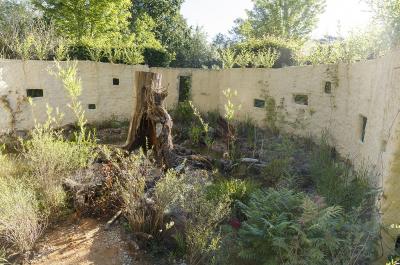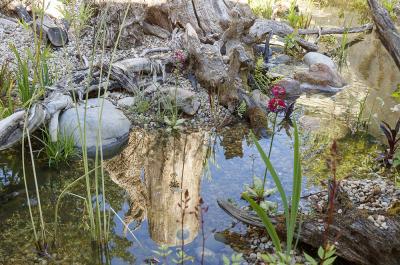13. Résilience et Anthropismes
Garden by Éric Lenoir

Résilience et Anthropismes is designed to tell a story which is both new and primordial. By being forced to go back to basics, we will be able to live happily and harmoniously as part of the global ecosystem, fully aware of our impact on biodiversity and that every action can have long-term effects if we do not respect the immeasurable complexity and fragility of the precious web of life. The difficulties to come and the damage that has already been done are clear, as is the hope that humanity will have the intelligence and humility to enable these things to be overcome, especially by learning from our mistakes.
Taking the shape of a heart (or perhaps a seed, the original cell, the spinal cord), this garden is based around a tree that appears to be dying, but from which sap-filled new growth appears. Concealed within the tree is the timeless beating heart of ever-living nature, primordial and powerful, the source of Life. The various shades of red that are dotted around – especially in the planting – is an allegory of blood vessels irrigated by the heart, wounds and the process of healing.
This “vital centre of life” is enclosed within what is sometimes a prison and sometimes a shield created by humanity. Everywhere we find the remains of industrialisation as the ground is artificially changed by urbanisation. But this does not stop plants from retaking it.
Plants that are directly useful to humanity grow alongside others that may appear uninteresting or toxic but which – due to the way they transform mistreated environments, their use in construction, the biodiversity to be regained, or the molecules they release – prove to be just as important. They are also a reminder that in order to confront the changes to come, we need to learn and relearn about our habitats and what is to be found in them.
DESIGNERS

Éric Lenoir is a landscape gardener and nursery gardener in Yonne, Burgundy, in the heart of France. He was a graduate of the École du Breuil, and over time he specialised in wild and aquatic environments, while never losing sight of his initial training in the more traditional gardens. He is passionate and very sensitive to the concept of ecology, his work is an example of an "off the beaten track" approach, thanks to his unwavering unique vision.
He was trained according to traditional methods, but is open to more modern techniques. He draws inspiration from his travels, his encounters, his years of observing nature and his own experience. He reproduces this knowledge and expertise in aesthetically-pleasing designs, his knowledge of plant life, and practices that are sustainable and respectful of the environment, with the ultimate aim of satisfying an ever diverse, and often demanding, customer base.
He is the author of several works, including Plantes aquatiques et de terrains humides (Aquatic Plants and Wetlands) published by Ulmer Editions and Petit traité du jardin punk (Little Punk Garden Treaty) (Prix St Fiacre 2019) published by Terre Vivante.


